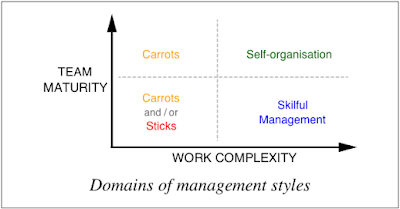"What are the pain points enterprise finance people have that would motivate them to move towards venture capital style funding models?"I'm not a finance guy, nor do I play one on TV, but I do have opinions, and I have worked for a venture capital funded startup, plus several traditional corporations.
In the abstract, my sense is that this is a typical "why don't people change when things are obviously bad" question. And the answer is usually some combination of: they don't feel the pain (although others do); they feel it, but don't have the tools to address it, or there's some other factor inhibiting change.
As always, the details matter so let's break it down. First, I'll describe the basic difference in the funding models; next I'll explain why Khali's question even makes sense; and finally I'll hazard an answer.
Startup funding vs Corporate funding
Many funded startups think in terms of "runway". Like a plane trying to take-off before it runs out of runway, startups try to achieve so-called product-market fit — i.e. a scalable business model — before their funding runs out. Many will do this in lean-startup fashion by running lots of rapid experiments as they refine both their product (or service), target market, and method of reaching that market. Now, it may be that there are extra injections of capital along the way, but these additional funding rounds will increasingly dilute the investments of the founders and early investors, unless the valuation grows sufficiently rapidly.My experience of working at a startup, especially in a leadership position, was influenced by the very real fear that the money would run out, and this drove us to keep trying new things.
By contrast, in traditional corporations funding typically revolves around an annual planning process in which the budget for various departments (or whatever) is allocated a year in advance, plus additional funding for major projects.
The corporate landscape has changed
This corporate funding model seems to have worked acceptably well in the past, but is now breaking down as complexity and uncertainty increase. No longer can organisations just continue to grind out profits based on the long-ago discovered business model, but they must continue to innovate improve, lest they go they be disrupted into oblivion. In other words they need to get back some of the quality of innovation that startups have in spades while continuing to deliver value.Practically speaking, the seemingly artificial requirement to forecast a year or more on advance acts as a brake on organisational responsiveness. Agile ways of working, by contrast, emphasise just-in-time decision-making, enabling rapid response to external threats and opportunities, and to internally generated insights.
Agilists would typically prefer a funding model that supported the new work structures that enable agility, such as bringing smallish chunks of work to stable, ideally high-performing teams rather than assembling teams to tackle large, annual funding sized programs of work. With stable teams (and teams of teams in place) some kind of portfolio planning can dynamically assign the highest value work to the teams without having to justify it a year or more in advance. This enables greater responsiveness in suitably skilled up and structured organisations.
And in turn, this inversion of funding teams rather than work leads to a desire for compatible forms of funding: for example block funding for teams rather than funding for large programs of work. However, currently most organisations are stuck with the older forms of funding leading to unnecessary waste in — for example — mapping the new work to the older funding structures, and needless alarm when the adaptive work systems create output that diverges from out-of-date plans.
What will it take?
Now, returning to Khali's question, I suspect that the issue is that the pains are either not being felt by the key decision-makers in finance, or — if they are — that they feel unequipped to change.To recap, the key pain points are:
- Insufficiently rapid response to externally changing conditions
- Waste generated by a mismatch between responsive (Agile) ways of working and older style funding mechanisms
In a coaching engagement with finance people using seemingly outdated methods, after first exploring their perspectives and pains, I would also investigate whether they were aware of the above two pains elsewhere in the organisation, and see how they respond to that information.
If they are aware of (or once they are made aware of!) the issues, I would enquire as to whether they feel equipped and empowered to help. Are they aware of alternative methods such as Beyond Budgeting, Conditional Budgeting, and Throughput Accounting that provide a modern body of knowledge from which to draw?
As with many examples of seeming inertia there may be a lack of awareness: if you're not feeling the pain, why change?! Or if there is awareness, there may be a lack of sufficient knowledge, skill, or empowerment to remediate the problem. And there also may be additional countervailing forces at work — it's always worth checking, and often surprising and humbling to find out what else is going on in any complex organisation!
If they are aware of (or once they are made aware of!) the issues, I would enquire as to whether they feel equipped and empowered to help. Are they aware of alternative methods such as Beyond Budgeting, Conditional Budgeting, and Throughput Accounting that provide a modern body of knowledge from which to draw?
As with many examples of seeming inertia there may be a lack of awareness: if you're not feeling the pain, why change?! Or if there is awareness, there may be a lack of sufficient knowledge, skill, or empowerment to remediate the problem. And there also may be additional countervailing forces at work — it's always worth checking, and often surprising and humbling to find out what else is going on in any complex organisation!




